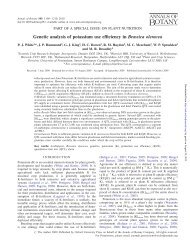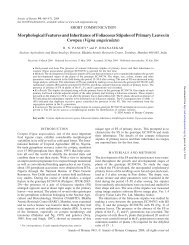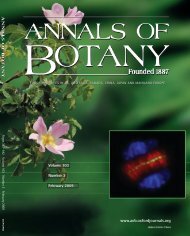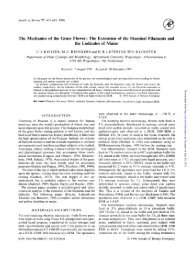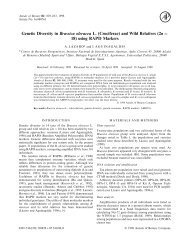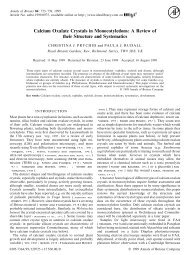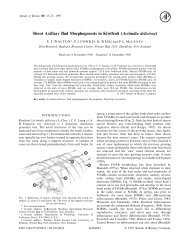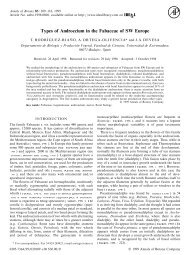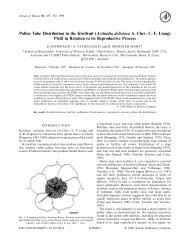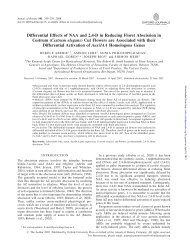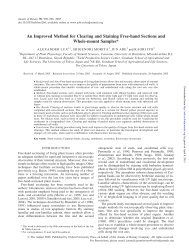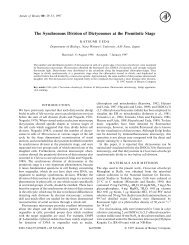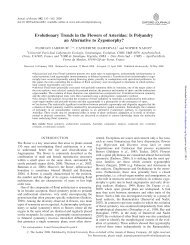Floral Structure of Kirkia (Kirkiaceae) and its ... - Annals of Botany
Floral Structure of Kirkia (Kirkiaceae) and its ... - Annals of Botany
Floral Structure of Kirkia (Kirkiaceae) and its ... - Annals of Botany
Create successful ePaper yourself
Turn your PDF publications into a flip-book with our unique Google optimized e-Paper software.
546<br />
Bachelier <strong>and</strong> Endress — Flowers <strong>of</strong> <strong>Kirkia</strong> <strong>and</strong> Position in Sapindales<br />
unplaced possibly sapindalean fossil L<strong>and</strong>eenia, approx. 18<br />
(Manchester <strong>and</strong> Hermsen, 2000). This tendency occurs even<br />
more generally in the entire malvids (Endress <strong>and</strong> Matthews,<br />
2006). Another pattern <strong>of</strong> interest is the co-occurrence <strong>of</strong> tetramerous<br />
<strong>and</strong> pentamerous flowers on the same individual, with<br />
the pentamerous ones especially on lower-order axes <strong>of</strong> the<br />
inflorescence, as also known from some Rutaceae (Ruta,<br />
Eichler, 1878; Skimmia, personal observation). In <strong>Kirkia</strong><br />
wilmsii trimerous, tetramerous, pentamerous <strong>and</strong> hexamerous,<br />
isomerous, flowers were found on the same individual. <strong>Floral</strong><br />
isomery is also common in Rutaceae (Engler, 1931b; Gut,<br />
1966; Ramp, 1988) <strong>and</strong> Simaroubaceae (Engler, 1931c;<br />
Ramp, 1988) but less so in Anacardiaceae <strong>and</strong> Burseraceae<br />
(Engler, 1931a; J.B.Bachelier<strong>and</strong>P.K.Endress,unpubl.<br />
res.). Rutaceae also exhibit many genera with tetramerous<br />
flowers. In contrast, in Anacardiaceae pentamerous flowers<br />
are common, <strong>and</strong> in Burseraceae trimerous flowers (Lam,<br />
1932; J. B. Bachelier <strong>and</strong> P. K. Endress, unpubl. res.).<br />
However, all numbers, three, four <strong>and</strong> five, combined with<br />
isomery, are present in Anacardiaceae, Burseraceae <strong>and</strong><br />
<strong>Kirkia</strong>ceae (<strong>and</strong> other Sapindales) in different frequencies<br />
<strong>and</strong> distribution. Whereas in Burseraceae isomerous flowers<br />
are common, as in <strong>Kirkia</strong>ceae, in Anacardiaceae they are<br />
largely restricted to Spondioideae (S. Pell, Brooklyn<br />
Botanical Garden, unpubl. res.).<br />
<strong>Floral</strong> cup <strong>and</strong> perianth<br />
The flowers have an exp<strong>and</strong>ed base <strong>and</strong> a shallow floral<br />
cup bearing the nectary disc. The cup is formed by the congenitally<br />
united bases <strong>of</strong> petals <strong>and</strong> stamens, <strong>and</strong> the median<br />
parts <strong>of</strong> the sepals. The sepal margins remain free <strong>and</strong> extend<br />
downwards as ledges for a short distance. Such free sepal<br />
margins on a floral cup or on a floral base without a cup<br />
are not restricted to Sapindales but also occur in other<br />
rosid groups. Although they are involved in the formation<br />
<strong>of</strong> the floral cup, sepals <strong>and</strong> petals are free among themselves,<br />
thus the perianth is chorisepalous <strong>and</strong> choripetalous<br />
in <strong>Kirkia</strong>ceae, as in many other Sapindales. According to<br />
Merxmüller <strong>and</strong> Heine (1960), in <strong>Kirkia</strong> dewinteri, the<br />
calyx is united for one-third <strong>of</strong> <strong>its</strong> length. If this is correct<br />
there would be free <strong>and</strong> united calyces in the genus.<br />
Sepals are deltoid <strong>and</strong> have three main vascular traces <strong>and</strong><br />
thus exhibit the shape <strong>and</strong> vasculature that is common in<br />
many rosids. The petals are acuminate <strong>and</strong> have a single vascular<br />
trace. They become longer than the sepals in older buds<br />
<strong>and</strong> thus have a protective function at this stage in<br />
<strong>Kirkia</strong>ceae, Anacardiaceae <strong>and</strong> Burseraceae, as also found<br />
in various other rosids (e.g. most Celastrales, some<br />
Oxalidales, some Crossosomatales <strong>and</strong> a few Chrysobalanaceae<br />
sensu lato; Matthews <strong>and</strong> Endress, 2002,<br />
2005a, b, 2008). Sepal aestivation <strong>of</strong> young floral buds is<br />
commonly valvate in <strong>Kirkia</strong>ceae, as in Burseraceae <strong>and</strong><br />
some Anacardiaceae. However, it becomes open in older<br />
buds when the petal bases exp<strong>and</strong> between the sepal bases,<br />
as also observed in Bursera (Burseraceae) (J. B. Bachelier<br />
<strong>and</strong> P. K. Endress, unpubl. res.). Petal aestivation is mainly<br />
imbricate <strong>and</strong> sometimes valvate (Oliver, 1868a, b;<br />
Stannard, 1981) in <strong>Kirkia</strong>ceae. Dense groups <strong>of</strong> secretory<br />
hairs with a short multiseriate stalk <strong>and</strong> large multicellular<br />
head at the inner base <strong>of</strong> the petals in <strong>Kirkia</strong> (see also<br />
Stannard, 1981) are unusual because they were not found<br />
in other areas <strong>of</strong> the flowers. In Beiselia there are secretory<br />
hairs with a large multicellular head, especially on the<br />
adaxial surface <strong>of</strong> the petal tips, but they have a uniseriate<br />
multicellular stalk as do all secretory hairs in<br />
Anacardiaceae <strong>and</strong> Burseraceae studied (J. B. Bachelier<br />
<strong>and</strong> P. K. Endress, unpubl. res.). These secretory hairs<br />
with multiseriate stalk may thus be an apomorphy for<br />
<strong>Kirkia</strong>ceae. Their concentration <strong>and</strong> restriction to a small<br />
area <strong>of</strong> the flower is suggestive <strong>of</strong> a specific function.<br />
However, since a disc that looks like a normal nectary is<br />
present, it is unlikely that the hairs are nectariferous (as is<br />
the case in the perianth <strong>of</strong> some Malvaceae; Vogel, 2000)<br />
(see below). It would be <strong>of</strong> interest to study the hairs in<br />
live material.<br />
Androecium<br />
Haplostemony, the presence <strong>of</strong> only one stamen whorl as<br />
consistent in <strong>Kirkia</strong>ceae is unusual for Burseraceae<br />
<strong>and</strong> occurs in only few genera (Triomma, some species<br />
<strong>of</strong> Canarium, Santiria, Protium <strong>and</strong> Crepidospermum;<br />
Leenhouts, 1956; Daly, 1989; Mitchell <strong>and</strong> Daly, 1993). In<br />
Anacardiaceae, haplostemonous flowers only occur in some<br />
Anacardioideae (Mitchell <strong>and</strong> Daly, 1993). The stamens <strong>of</strong><br />
haplostemonous flowers are alternipetalous in all three<br />
families. Flowers with two stamen whorls in Anacardiaceae<br />
<strong>and</strong> Burseraceae (J. B. Bachelier <strong>and</strong> P. K. Endress, unpubl.<br />
res.) <strong>and</strong> other Sapindales (Rutaceae, Beille, 1902; Eckert,<br />
1966; Gut, 1966; Simaroubaceae, Nair <strong>and</strong> Joseph, 1957;<br />
Nair <strong>and</strong> Joshi, 1958; Narayana <strong>and</strong> Sayeeduddin, 1958;<br />
Eckert, 1966) are commonly obdiplostemonous, i.e. the antepetalous<br />
stamens have a smaller base than the antesepalous<br />
ones, <strong>and</strong>, in isomerous flowers, the carpels are positioned<br />
in the antepetalous radii (contrary to expectation based on<br />
regular alternation <strong>of</strong> whorls) because there is more space<br />
available in this position. That the anthetic antepetalous<br />
stamens are less developed is commonly obvious also by<br />
their shorter filaments, as in Anacardiaceae <strong>and</strong> Burseraceae<br />
(J. B. Bachelier <strong>and</strong> P. K. Endress, unpubl. res.), <strong>and</strong> is a<br />
common situation also in many other rosids. Haplostemonous<br />
flowers with alternipetalous stamens as in<br />
<strong>Kirkia</strong>ceae may be seen as an extreme case in this trend: as<br />
complete suppression <strong>of</strong> the antepetalous stamens. Among<br />
other Sapindales, flowers in Meliaceae are mostly obdiplostemonous,<br />
rarely diplostemonous (with the carpels alternipetalous),<br />
sometimes haplostemonous with the carpels<br />
antepetalous, rarely alternipetalous (Harms, 1940); in haplostemonous<br />
Rutaceae the stamens are alternipetalous (Beille,<br />
1902; Engler, 1931b), in Simaroubaceae alternipetalous<br />
(Brucea, Picrasma) or antepetalous (Picrolemma, Engler,<br />
1931c). Thus the position <strong>of</strong> stamens in haplostemonous<br />
flowers in families <strong>of</strong> Sapindales other than the clade <strong>of</strong><br />
<strong>Kirkia</strong>ceae–Anacardiaceae–Burseraceae appears less fixed.<br />
Stamen shape in <strong>Kirkia</strong>ceae corresponds to a common<br />
type in Sapindales <strong>and</strong> other rosids with sagittate, slightly<br />
dorsifixed, introrse anthers, <strong>and</strong> with a relatively narrow<br />
transition region between filament <strong>and</strong> anther (Endress<br />
<strong>and</strong> Stumpf, 1991; Matthews <strong>and</strong> Endress, 2002, 2004,




